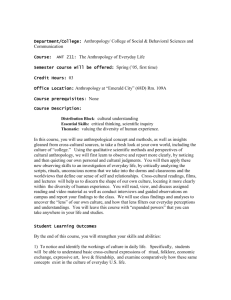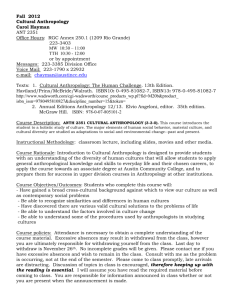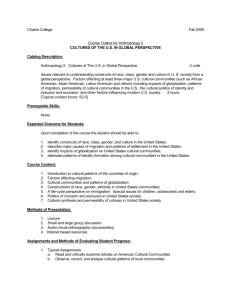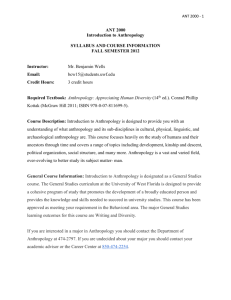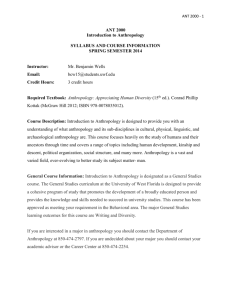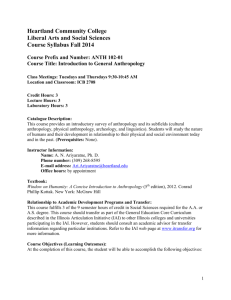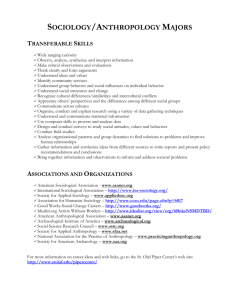Borough of Manhattan Community College
advertisement
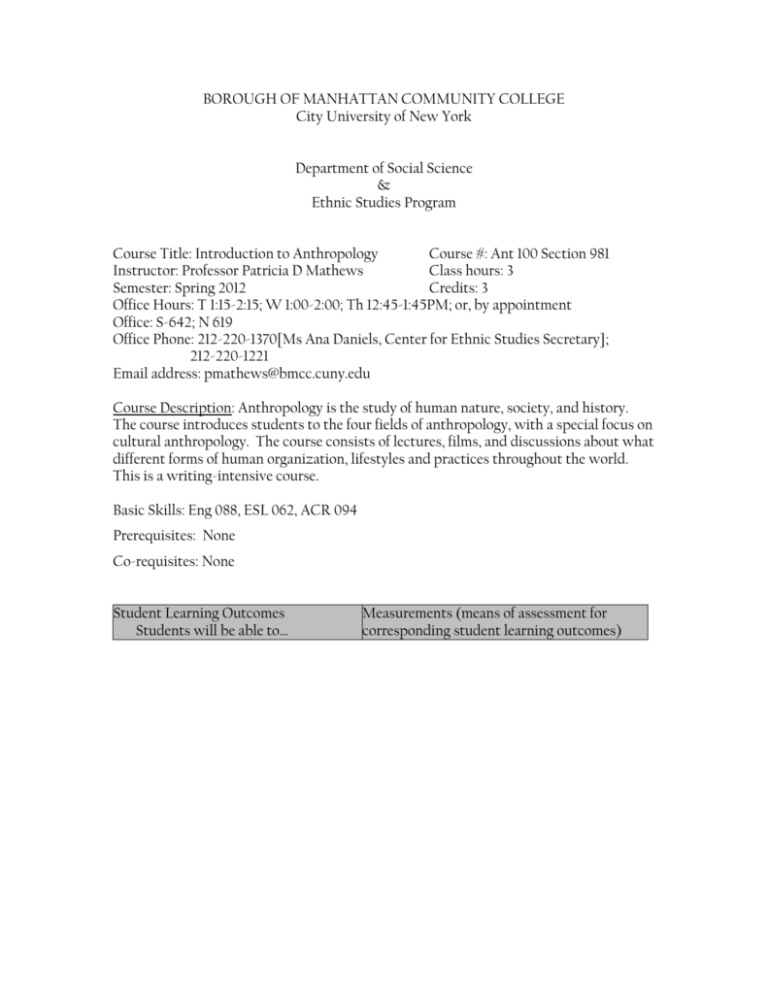
BOROUGH OF MANHATTAN COMMUNITY COLLEGE City University of New York Department of Social Science & Ethnic Studies Program Course Title: Introduction to Anthropology Course #: Ant 100 Section 981 Instructor: Professor Patricia D Mathews Class hours: 3 Semester: Spring 2012 Credits: 3 Office Hours: T 1:15-2:15; W 1:00-2:00; Th 12:45-1:45PM; or, by appointment Office: S-642; N 619 Office Phone: 212-220-1370[Ms Ana Daniels, Center for Ethnic Studies Secretary]; 212-220-1221 Email address: pmathews@bmcc.cuny.edu Course Description: Anthropology is the study of human nature, society, and history. The course introduces students to the four fields of anthropology, with a special focus on cultural anthropology. The course consists of lectures, films, and discussions about what different forms of human organization, lifestyles and practices throughout the world. This is a writing-intensive course. Basic Skills: Eng 088, ESL 062, ACR 094 Prerequisites: None Co-requisites: None Student Learning Outcomes Students will be able to… Measurements (means of assessment for corresponding student learning outcomes) a) Students who take this course a) Questions on quizzes and exams will will develop an understanding of require students to describe specific human diversity and they will be events and offer explanations of the same able to explain patterns of using information from assigned readings behavior among human cultures and material explained in class; across time and throughout the b) Reading material, visual aids, discussion world. board and assignments will test regularly b) Students will broaden their this understanding of cultural relativity, minds by learning how our own respect for difference and understanding understanding is culturallyof diversity; based and how the cultural perspective is embedded in our worldview and understanding of what is right and wrong. c) Besides the understanding of c) Class assignments will regularly ask difference and diversity, this students to identify the common traits course enables an understanding that all human societies and individuals of the commonalities of all have in addition to the apparent humans as members of one race. differences among them. d) The explanation and mapping of d) Students will locate different societies different societies and cultures and cultural regions in different maps. will develop an awareness of Progress will be attained by regular spatial differences and exercises, quizzes and class discussion; geographic settings that shape and are shaped by human groups. General Education Goals that will be covered and assessed in this course: Communication Skills Measurements Students will read, write and share their thoughts in various contexts. Some will be informal conversations among each other, but most of the measurement will be held during participation in the discussion board, and individually in class assignments and in their papers and presentations. Social and Behavioral Sciences Students will incorporate the language of anthropology to the discussion of human practices in cross cultural perspective. They will apply the methods learned in this course and will try to approach each case study looking at each culture in their own value. This constant exercises aims at the exercise of tolerance and respect for cultural and human diversity. Required Text & Readings: 1. Kottak, Conrad Phillip.Windows on Humanity. McGraw Hill, 2010. 2. Angeloni, Elvio. Anthropology Annual Editions 11/12. McGraw Hill. List of Books: [You need to read at least TWO chapters of ONE of these books: Dettwyler, Katherine.1994. Dancing Skeletons. Life and Death in West Africa. Waveland Press. Farmer, Paul.2006. Aids and Accusation. Haiti and the Geography of Blame. University of California Press. Shostak, Marjorie.2000. Nisa.The Life and Words of a !Kung Woman. Harvard University Press. Wilkinson, Daniel.2004. Silence in the Mountain. Stories of Terror, Betrayal and Survival in Guatemala. Duke University Press. Evaluation & Requirements of Students: There are Three Tests and One Final Exam. The final will be averaged to the result of test average. 50% Participation is measured by the quality, requested frequency, and timeliness of your postings on the Discussion Board. 20% Reports: based on selected chapters of one book in the recommended books list. 30% PLEASE NOTE: There are no make-ups for tests or assignments. College Attendance Policy: At BMCC, the maximum number of absences is limited to one more hour than the number of hours a class meets in one week. For example, you may be enrolled in a threehour class that meets twice a week. You are allowed 4 hours of absence (not 4 days). In the case of excessive absences, the instructor has the option to lower the grade or assign an F or WU grade. In the online classes attendance is based on your timely postings on the discussion board. Make sure you check both your BMCC email and announcements at least once a day in case there is any relevant information on the course. Academic Adjustments for Students with Disabilities: Students with disabilities who require reasonable accommodations or academic adjustments for this course must contact the Office of Services for Students with Disabilities. BMCC is committed to providing equal access to all programs and curricula to all students. BMCC Policy on Plagiarism and Academic Integrity Statement: Plagiarism is the presentation of someone else’s ideas, words or artistic, scientific, or technical work as one’s own creation. Using the idea or work of another is permissible only when the original author is identified. Paraphrasing and summarizing, as well as direct quotations, require citations to the original source. Plagiarism may be intentional or unintentional. Lack of dishonest intent does not necessarily absolve a student of responsibility for plagiarism. The library has guides designed to help students to appropriately identify a cited work. The full policy can be found on BMCC’s web site, www.bmcc.cuny.edu OUTLINE OF TOPICS This outline includes various sites that you may visit and refer to before participating in the discussion board and before writing your assignments. Week One: F 8/26 Welcome – Getting Started Week Two: W 8/31, F 9/2 Introduction. What is Anthropology? Kottak, Chapter 1 Week Three: W 9/7, F 9/9 What is Culture? Kottak, Chapter 2 Bohannan, Laura “Shakespeare in the Bush.” In: Angeloni pp 60-63 Week Four: W 9/14, F 9/16 Evolution, Genetics, and Human Variation Kottak Chapter 4 http://www.talkorigins.org/faqs/homs/ (fossil hominids site) http://www.pbs.org/wgbh/evolution/humans/humankind/a.html(human origins) David Shenk. Can White Men Jump? Ethnicity, Genes, Culture and Success. From the Genius in All of Us, Doubleday, 2010. In: Angeloni pp32-35 Week Five: W 9/21, F 9/23 Ethics and Methods Kottak, Chapter 3 Case study: To Medicate or Not to Medicate (it will be posted as a course document) http://www.aaanet.org/committees/ethics/ethic.htm http://www1.truman.edu/academics/ss/faculty/tamakoshil http://maxweber.hunter.cuny.edu/anthro/field.html http://www.aaanet.org/committees/ethics/ethic.htm Week Six: W 9/28, F 9/30 NO CLASSES SCHEDULED Week Seven: W 10/5, NO CLASSES SCHEDULED FOR F 10/7 Research Methods Chapter 2 Chagnon, Napoleon. “Doing Fieldwork Among the Yanomamo” In: Angeloni, pp 10-21 Gmelch, George. “Lessons From the Field” In: Angeloni, pp 14-19. Lee, Richard.“Eating Christmas in the Kalahari.” In: Angeloni, pp 22-25. Sterk, Claire. “Tricking and Tripping: Fieldwork on Prostitution in the Era of AIDS” In: Angeloni, 26-31. TEST #1 Week Eight: W 10/12, F 10/14 Language and Culture Kottak, Chapter 10 Tannen, Deborah. “Fighting For Our Lives” In: Angeloni, 32-41. Tannen, Deborah. “ I Can’t Even Open My Mouth.” In Angeloni, 42-50 [earlier editions]. Schildkrout, Enid. “Body Art as Visual Language.” In: Angeloni, 56-59 Week Nine: W 10/19, F 10/21 Ethnicity and Race Kottak Chapter 17 www.pbs.org: Race, The Power of An Illusion. TEST #2 Week Ten: W 10/26, F 10/28 Making a Living Kottak, Chapter 11 Nelson, Richard. “Understanding Eskimo Science” In: Angeloni 63-65. Gadsby, Patricia. “The Inuit Paradox.” In: Angeloni 81-84 Week Eleven: W 11/2, F 11/4 Families, Kinship and Marriage Kottak, Chapter 13 Goldstein, Melvyn.“When Brothers Share a Wife.” In: Angeloni, 87-89 Scheper-Hughes, Nancy. “Mother’s Love: Death Without Weeping.” In: Angeloni, 95-99. Nanda, Serena. “Arranging a Marriage in India.” In: Angeloni 107-111. Kristof, Nicolas. “Who Needs Love! In Japan, Many Couples Don’t.” In: Angeloni, 112-115. http://www.umanitoba.ca/faculties/arts/anthropology/kintitle.html Week Twelve: W 11/9, F 11/11 Gender Kottak Chapter 14 Ward, Martha. “A World Full of Women.” In: Angeloni, 118-126. Williams, Walter. “The Berdache Tradition.” In: Angeloni, 127-132. Simmons, Ann. “Where Fat is a Sign of Beauty.” In: Angeloni, 137-138. Week Thirteen: W 11/16, F 11/18 Religion-- Belief Systems in Various Societies Kottak, Chapter 15 Lehmann, Arthur. “Eyes of the Ngangas: Ethnomedicine and Power in Central African Republic.” In: Angeloni, 145-152. Del Guercio, Gino. “The Secrets of Haiti’s Living Dead.” In: Angeloni, 163-166. Gmelch, G. “Baseball Magic.” In: Angeloni 170-175 TEST #3 Week Fourteen: W 11/23, NO SCHOOL –THANKSGIVING DAY WEEKEND The World System and Colonialism Kottak Chapter 16 Laura Graham, The Tractor Invasion In: Angeloni 183-186 John Bodley, The Price of Progress In: Angeloni 205-211 Diamond, Jared. “The Arrow of Disease.” In: Angeloni, 191-197. “Malthus in Africa.” 205-212. “The Last Americans.” 225-232. Week Fifteen: W 11/30, F 12/2 Applying Anthropology & Global Issues Today Kottak, Chapter 18 &19 Jim Igoe, Seeing Conservation through the Global Lens. In; Angeloni pp213-222 Tsuda, Takeyuki.” No Place to Call Home.” In: Angeloni, 192-193[earlier editions]. Week Sixteen: W 12/7, F 12/9 Conclusions W 12/14 READING DAY F 12/16 FINAL EXAM
